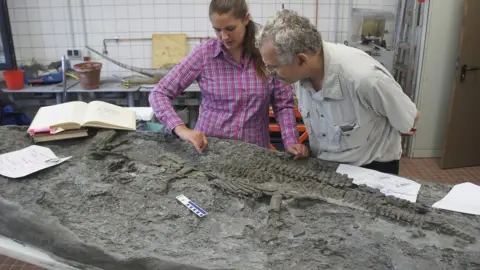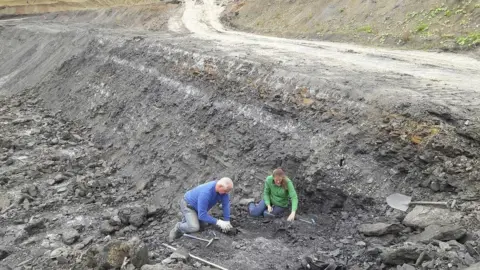Sea reptile fossil gives clues to life in ancient oceans
 Yasuhisa Nakajima
Yasuhisa NakajimaA new fossil is shedding light on the murky past of the sea reptiles that swam at the time of the dinosaurs.
With tiny heads on long necks and four pointed flippers, plesiosaurs have been likened to Scotland's mythical Loch Ness monster.
The German discovery proves that these sea creatures were alive more than 200 million years ago during the Triassic.
The fossilised bones give clues to how the animal survived a mass extinction that wiped out most living things.
''We now have the proof that this extremely successful group of marine reptiles already existed during Triassic times,'' said paleontologist Martin Sander of the University of Bonn, who examined the fossil with colleague, Tanja Wintrich.
''This had been suspected for over 150 years, but it took a surprisingly long time for the hard evidence to emerge. ''
Long reign
The plesiosaur has been named Rhaeticosaurus mertensi.
Growth marks in its bones suggest the sea creature was a juvenile, grew very quickly and was warm-blooded.
 Georg Oleschinski
Georg OleschinskiBy being warm-blooded, plesiosaurs were able to roam the open seas in late Triassic times.
''Warm-bloodedness probably was the key to both their long reign and their survival of a major crisis in the history of life, the extinction events at the end of the Triassic,'' said Prof Sander.
Plesiosaurs were not as hard hit by the extinction as shallow water and coastal animals. Their fossils have been found all over the world in Cretaceous and Jurassic rocks.
''What is also interesting is the location of the find in Germany, in Europe,'' said Prof Sander.
''Three hundred years ago, the first plesiosaurs were found in England and the Continent, and now we have come full circle.''
The scientists found the skeleton buried in a clay pit owned by a German brick company near the village of Bonenburg.
The creature had a very stiff neck, which probably prevented it from twisting its head from front-to-back or side-to-side.
The research is published in the journal, Science Advances.
'''Triassic plesiosaur remains are few and far between, so the discovery of Rhaeticosaurus mertensi is really important in helping to understand what early plesiosaurs looked like,'' said Dean Lomax of the University of Manchester, who was not connected with the study.
'''This will also provide new information about the early evolution of the group.''
 Martin Sander
Martin SanderPlesiosaurs ruled the oceans for more than a hundred million years before dying out at the same time as the dinosaurs.
Despite their dominance of the prehistoric oceans, there are still many unanswered questions about their biology, anatomy and evolution.
Follow Helen on Twitter.
